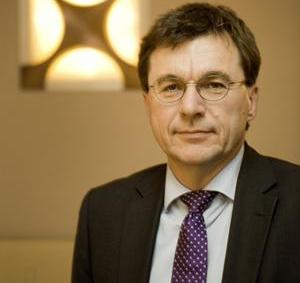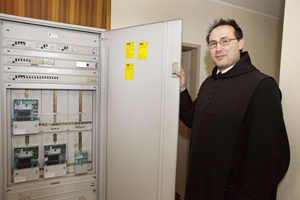Smart grid revolution gets underway in Austria
on
Smart grid revolution gets underway in Austria
One of Europe's most comprehensive smart grids is currently coming into existence in Austria. Energie AG Oberösterreich has been rolling out 21,000 smart meters, with 80,000 more to follow by the end of next year. A new tariff will enable homeowners to pay different rates at different times of the day. German technology giant Siemens, the supplier of the smart grid infrastructure, banks on a robustly growing market. Siemens and Energie AG say the new smart grid will benefit customers as well as the utility. But there are concerns, too, for example about the costs for consumers and the impact on their privacy.
 |
| 'If only our grid had a brain', a GE advertisement on smart grids during the American Superbowl 2009 (Photo: GE) |
Father Leopold Fürst, an Austrian pastor with thin-rimmed glasses, disheveled hair and a warm smile, opens a cabinet door in his house in St. Konrad in Upper Austria, to show off his new gadget. 'So, here it is,' he says, smiling a bit uncomfortably in light of the crowd of journalists and photographers that has squeezed into the small corridor of his home to look at a grey rectangular box.
The box is a Siemens AMIS "smart meter", one of the most advanced models available. It not only measures electricity consumption, but also covers the entire energy supply chain, from power plant to consumer, by communicating through the power grid.
Father Leopold's meter is one of 21,000 that have been installed by Linz-based Energie Oberösterreich in Upper Austria, and the utility says this is just the beginning.
For a total investment of an estimated €150 million, Energie AG, which employs roughly 7,000 people, aims to overhaul Upper Austria's electricity network to make it fit for the new energy age. The company will build new transformer stations, modernise grid lines and install 500,000 smart meters over the next decade. It will try to recoup a large part, if not all of its investments, through higher tariffs – if allowed to do so by the regulator.
Futuristic
'What's happening here in Upper Austria really is a revolution', Werner Steinecker, Energie AG's chief technical officer, tells a small group of journalists at the company's Solar Campus, a futuristic, box-shaped building made of steel and glass that overlooks fields decked with shiny blue solar cells.
Energie AG says it will introduce a new power tariff this summer that enables customers with a smart meter to pay variable rates at different times of the day. Electricity will be cheaper, for example, at night or in the morning, and more expensive during times of peak demand. Customers who program their
| That Hausmann was asked to lead the smart grid business shows that Siemens takes this dynamic new market very seriously |
The company has realised that it can also profit from the smart grid. By shifting consumption away from peak demand times, Energie AG can save real money because it doesn't have to buy as much expensive peak power. The network also benefits, as Energie AG, using its smart grid infrastructure, can intelligently manage demand and supply so that outages are less likely to happen. Moreover, Energie AG doesn't need to send employees to switch power on and off, or check consumption on site. The smart meter investment, Steinecker says, could be amortized within 12 years. 'It's really a win-win situation,' he says.
Top-notch cuisine
 |
| Hausmann: 'There is no alternative to modernising the existing grids and making them more intelligent.' (Photo: Siemens AG) |
'Overall power consumption is rising, more fluctuating renewables are integrated into the grid and the networks are becoming older,' says Hausmann. 'There is no alternative to modernising the existing grids and making them more intelligent.' Hausmann reveals that Siemens aims for €6 billion turnover in smart grids until 2014. 'n the five-year range 2010 to 2014, the global smart grid sector, which includes intelligent power lines, sensorics and transformer technology, is a €100 billion market, of which Siemens can address €30 billion. We want a 20 percent share of that,'he says. This translates into €6 billion.
Siemens' smart grid sales in 2010 grew by 10 percent compared to the previous year, to €1.1 billion, Hausmann says. The company not only builds smart meters, but also develops high-voltage grid infrastructure, charging stations for electric cars and software to make power consumption more efficient and flexible. Sales in the latter category, the so-called smart grid applications, will 'grow strongly', Hausmann says.
Start-ups
According to Hausmann, the most dynamic markets for smart grid applications are China and the United States rather than the European Union. The two markets are very different from each other. In China, Siemens will – among other things – push so-called microgrid solutions, meaning that remote communities can become self-sufficient and independent from the larger grid. In the United States, which is the most advanced smart grid market, companies are already selling various smart grid applications. In these two growth markets, Siemens competes with the likes of General Electric, ABB, Schneider Electric and a host of smaller start-ups. To succeed, Siemens will push its internal development, and also look to buy small and medium-sized companies, Hausmann says.
 |
| Father Leopold Fürst shows the Siemens AMIS smart meter (Photo: Siemens AG) |
For consumers the investments might lead to higher bills. What they save in power consumption, they might have to pay in higher grid transmission tariffs, which are set to rise after all the expensive investments – even the experts at Energie AG admit that.
Meanwhile, consumer protection agencies and others are concerned by the wealth of information that private households will be forced to share with utilities. In most countries there are still a lot of uncertainties over how such data should be regulated and how the privacy of consumers can be protected.
Critics are also concerned that a smart grid might lead to environmental dictates that interfere with consumers' freedom of choice. For example, people may be more or less forced to wash their clothes at 3 a.m. or face punitive power tariffs.
E-cars
Energie AG says these concerns are unnecessary. Johann Kaltenleithner, who is the smart grids project leader at Energie AG, points out that appliances such as dishwashers, washers and dryers account for just 8.5 percent of a typical Austrian household's energy consumption. The real energy gobblers, he says, are heating and warm water systems, which make up 85 percent of consumption. In regions where a lot of heat pumps are installed – such as in Upper Austria – customers can run them according to the new tariffs without even noticing a difference in temperature or warm water availability.
And a functioning smart grid such as the one Energie AG has in mind for Upper Austria will, in future, be able to do a lot more than just provide flexible tariffs. For example, it will enable homeowners to sell power generated by their rooftop solar panels directly to the grid, or use it at home when prices are high.
| Critics are also concerned that a smart grid might lead to environmental dictates that interfere with consumers' freedom |
For Father Leopold Fürst, the notion of increased transparency is definitely appealing. 'It will be nice, to see how much power I'm consuming each day,' he says. After a pause, he adds, with a shrug and a smile: 'But in my case, I won't be able to save too much, I guess. I'm a single household, you know.'


Discussion (0 comments)